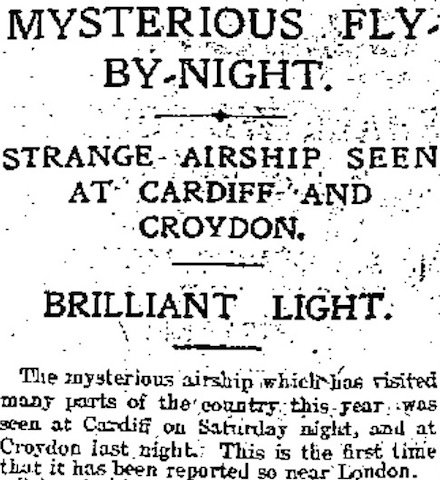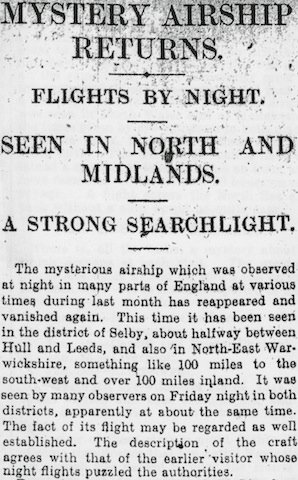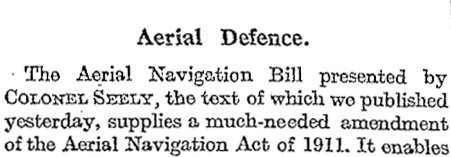Any provincial newspaper with pretensions to quality features a regular column from its (usually anonymous) London correspondent which offers a mixture of political gossip and analysis as well as anecdotes of life in the capital and other, less classifiable tidbits. Today’s ‘Our London correspondence’ column in the Manchester Guardian, for example, previews the coming week in Parliament, analyses religious demographics in Londonderry, and discusses the ‘new terror’ of taxi whistles on London streets (p. 6). It also has two paragraphs on ‘The mysterious airship’, based on a conversation with ‘a friend who watches the progress of aeronautics very closely’. It seems that
people of his sort are inclined to take the reports of the airship that travels by night seriously, and to hold that, though two or three of them (I am afraid the Manchester report is one) seem to be the product of self-deception, there is now a strong enough body of evidence to make it reasonably certain that in the course of the last two months an airship travelling by night has been seen at Sheppey, at Dover, and at different points on the Welsh coast of the Bristol Channel.
The Guardian‘s correspondent seems to doubt the claim that the Dover airship was the privately-owned Hansa: ‘but I believe this theory was arrived at by a process of elimination, the movements of the German Government airships having been traced on the night in question’. As to ‘the theory in Wales […] that the vessel belongs to some experimenter living on the Devonshire moors’,
It seems important to observe that the direction in which the ‘mystery’ vessel was moving and the places at which it was seen would point even more cogently to experiments conducted from Salisbury Plain. It may be added that, though a private experimenter who only flew at night would be a lunatic, there might be a very definite purpose in keeping quiet by day if the experimenter were a Government department. I learn from my friend that there is much comment on the darkness which has fallen on the Government’s experiments in regard to dirigibles of the rigid type since the unfortunate accident to the naval airship No. 1 at Barrow two years ago. This year’s Estimates will probably contain provision for new and slightly smaller vessels of this type. Is it possible that something has been accomplished already?
This is in line with earlier, vaguer hints in the Guardian that government or government-commissioned airships might have been responsible for the South Wales sightings, but the definite suggestion that it is a secret new government (presumably military) airship operating from Salisbury Plain appears to be new.
There follows a brief recollection of the 1909 airship scare, under the heading ‘A precedent for sceptics’:
Sceptics may comfort themselves by remembering that it was in South Wales not so very long ago that chance and the romantic imagination of a nocturnal wanderer combined to perpetrate the great airship hoax. The wanderer told the story, and chance produced the little tag printed in French which, when first translated, seemed to refer obscurely to shrapnel shell, but was ultimately found to be a very lucid piece of instruction in the use of motor-tyre valves. Such as the inferences to which the technical terms of a foreign tongue may lead the imagination.
A striking phrase that, ‘the great airship hoax’. However, while this account is accurate as far as it goes, it is misleading in its implication that C. Lethbridge’s strange encounter on Caerphilly Mountain was the cause of the scare, when it actually came at the peak, after a build-up of a week or more. It was more the cause of the end of the scare, as the sudden deflation of the sensational story contributed to a more general scepticism about the phantom airships.
![]() This work is licensed under a Creative Commons Attribution-NonCommercial-NoDerivatives 4.0 International License.
Permissions beyond the scope of this license may be available at http://airminded.org/copyright/.
This work is licensed under a Creative Commons Attribution-NonCommercial-NoDerivatives 4.0 International License.
Permissions beyond the scope of this license may be available at http://airminded.org/copyright/.





